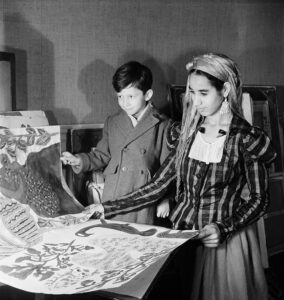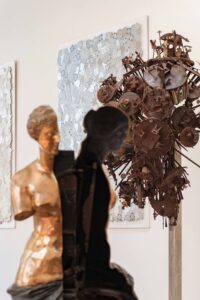
Walking Man I, 1960
“A woman, I always make immobile, and a man, I always have him walking”. Alberto Giacometti
In 1947, Giacometti ended ten years spent observing the model to best express reality and – according to him – as he did not manage to do so, he started working on his sculptures from memory, “but strangely, they only looked like each other when they were long and slim” (A.G., in 1948, Letter to Pierre Matisse, Ecrits, 199, p. 44). The Walking Man was displayed in the artist’s first exhibition at the Pierre Matisse Gallery in New York in 1948.
Along with Monumental Head and Large Women Standing, a request made to Giacometti in 1958 by the American architect Gordon Bunshaft, who designed the sixty floors of Chase Manhattan Bank in New York, provided the inspiration for this sculpture.
Alberto Giacometti (1901 - 1966)
In 1959, the architect responsible for the new Chase Manhattan Bank headquarters in New York asked Alberto to create large sculptures for the Plaza. Alberto got to work straight away and made the Walking Man and the Tall Standing Woman (almost three metres high), among others. Ultimately the sponsor did not choose his project. Pierre Matisse also refused these works, which he deemed “too difficult”. My father therefore suggested that Alberto use the central open area of the Saint-Paul Foundation, which was being built. Alberto came to paint the bronzes — not give them a patina — himself and install them in the Courtyard. This Courtyard is now known throughout the world as the “Giacometti Courtyard”. He chose and often changed where of each of his sculptures was placed: he placed the Woman of Venice series, the two Walking Man and the two Tall Standing Woman around Diego’s Large Head… He spent a lot of time at the Foundation. He was happy surrounded by his sculptures. He often changed their positioning, adding The Cube, removing The Dog. Nothing was set. He liked his large figures to be exposed to nature, trees, the colour of the Foundation’s brick, or that of the terracotta flagstones in the rooms. That was why he painted some of the bronzes we have at the Foundation, so they were in harmony with the light and colours of the South. Adrien Maeght



